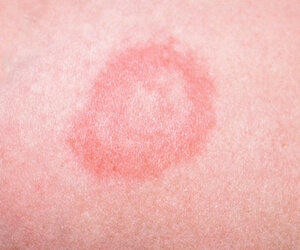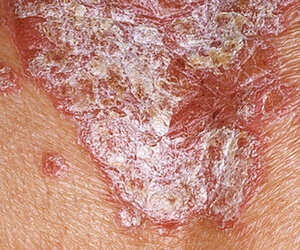Psoriasis is characterized by remission and exacerbations. Dermatitis occurs in several stages: initial, progressive, standing, regressive. This separation facilitates diagnosis and appropriate therapy.
Interesting to know
Psoriasis is a genetic disease. About 10% of the population has characteristic DNA disorders and only 2% have skin dysfunctions.
The following factors provoke the appearance of pathology:
- strong emotional stress;
- injuries;
- alcohol consumption, smoking;
- unbalanced diet;
- infectious and other diseases;
- certain medications;
- endocrine diseases;
- predisposition to allergies;
Due to an improper reaction of the immune system to foreign elements in the epidermal tissue, the first signs of the disease appear. Consider the stages, symptoms, and treatment regimen of psoriasis.

The initial stage of psoriasis
The first sign is the appearance ofacne(papules). Rounded shape, reddish or pink. A bluish tinge may appear on the lower limbs due to slow blood flow. Papular formations are small, the size of a needle head.
The early stage is characterized bymany papuleswith well-defined boundaries. Whitish scales also appear. They can be easily separated from the surface with a touch. The papules can come together to form larger elements.
During early remission, the lesions turn pale. Affected skin surfaces are partially discolored. In children, this stage of psoriasis is often confused with the manifestation of allergy or diathesis. The rash can cause severe itching. Signs used to diagnose psoriasis include
- When scraping, the surface of the plaque becomes whitish, resembling a rubbed drop of stearin, the scales detach;
- If you continue to scrape off the stain and remove the scale, a bright red surface will appear; When scraping
- , small droplets of blood appear.
Progressive stage of psoriasis
In the progressive stage of psoriasis, the following symptoms occur:
- The papules turn red, still covered with white scales. They are easily peeled, with a smooth, reddened layer of skin underneath. When injured, blood appears.
- With aggravation, the papular elements grow and merge. They are clearly different from healthy skin surfaces.
- Itching more severely. But the process passes as it transitions to a stationary phase. Painful and obsessive itching that interferes with sleep and daily activities. If you just scratch the cover, damage and new plaques will appear. The appearance of new plaques at the site of injury is Koebner syndrome. The number of manifestations of itching gradually increases, covering the body, limbs, head.
- There are no scales on the edges of the plaques, they are hyperemic, indicating the continuation of the inflammatory process.
Consequences
Psoriasis can negatively affect the joints (psoriatic arthritis). Then there are severe pains in the joints, their deformation if the process is left untreated.
Inpatient phase of psoriasis
The main feature of the stationary phase of psoriasis is that no new elements appear. With the right treatment, positive changes will occur.

Clinical manifestations:
- eliminates itching;
- no injury (Koebner symptom goes away); Exfoliation of
- may increase.
All spots stop. If in the progressive stage the plaques had an unbalanced edge, then in the stationary stage the entire inflamed surface of the integument peels off, giving it a characteristic psoriasis appearance.
Scales are characteristic of the last stage of inflammation. At the onset of pathology, the balance does not keep pace with the progressive growth of plaques and cannot completely cover them. In half of the cases, apseudoatrophic corolla.
Pseudoatrophic corolla
It looks like a light edge around the element, the structure of which resembles coarse tissue paper, which consists of a corner layer and its width does not exceed two millimeters.
Regressive stage of psoriasis
In the regressive phase of psoriasis, the psoriasis cycle ends. Key Features:
- the exacerbation process stops, the inflammation goes away; the
- plaques gradually dissolve; Exfoliation
- stops, the elements of the rash flatten out;
- the rash turns pale pink, gradually discolored;
- papules can still remain on the arms and elbows.
No scarring or atrophy remains in the affected area. Transient hyperpigmentation or pigment-free areas may occur at the site of rash.
Remission occurs after complex therapy.The period of relief is individual. Latent illness can last for months or even years. Exacerbations are more common in winter, with the exception of some forms of psoriasis.
Treat psoriasis in different stages
Therapy for any form of psoriasis consists of general and topical treatment, physiotherapy, and dietary adjustment. Required in the early stages of therapy:
- gives up bad habits;
- Strictly follow a therapeutic diet;
- use ointments that contain vitamins A, D3, hormones;
- use of systemic and sedative drugs;
- undergoes ultraviolet therapy.
If the plaques are on your head, your doctor will prescribe tents based on tar, zinc, selenium sulfide.
All money should be used as directed by your doctor. Long-term use of medications (especially with tar) can irritate the skin. The funds must be changed every 7 days.
Early treatment for psoriasis
The effectiveness of early treatment interventions depends on when the patient sees a doctor and begins treatment.
Early therapy in most cases helps prevent the disease from progressing to a chronic form.
Experts recommend the use of salicylic acid ointment. It is an anti-inflammatory and antimicrobial drug that has a beneficial effect on the affected skin surfaces. With a keratolytic effect, the ointment cleanses the plaque from the entire keratinized parts. Naphthalene ointment helps relieve itching.
Medications are usually prescribed:
- based on tar
- ; solid oil based
- ;
- is oil based.
Not so long ago there were drops and oils for psoriasis. The device is able to soothe the skin, hydrate, prevent dehydration of the skin and relieve swelling. The preparation contains ubiquinone, beta-carotene, snow fat, propolis, pumpkin seed oil and other ingredients that help reduce the number of plaques, make them less hydrated. It is recommended to use it together with other medicines and after consulting a specialist.
Treatment of psoriasis in the progressive stage
Therapy should be comprehensive and prudent. The clinical picture is quite difficult, the treatment can only be entrusted to specialists. Intravenous and intramuscular administration of special drugs helps patients. Sorbents help remove toxins from the body.
Manifestations remove salicylic acid ointment, emollient emulsions. They hydrate and reduce inflammation. Medicines containing tar or other irritants should not be used during exacerbations.
Physiotherapy procedures (PUVA therapy, ultraviolet irradiation, paraffin application) are best performed during the period of inflammation reduction. Corticosteroids and cytostatics are prescribed only if the processes are particularly complex.
Prescribe antihistamines (reducing the development of allergic reactions), sedatives (sedatives), anti-inflammatory drugs, keratolytics (emollients), diuretics (relieves swelling, removes toxins).
Treatment of stationary psoriasis
The patient needs a slight correction in therapy. Tar shampoos, oil emulsions, calcipotriol are usually prescribed. Systemic therapy is used when the disease affects large areas of the integument. Ultraviolet irradiation and the PUVA technique are widely used.
If there is no effect, some cytotoxic drugs are prescribed. In severe cases, the patient is prescribed an immunosuppressant, a cytotoxic.
Treatment of psoriasis in the regressive stage
Treatment in the last stage of psoriasis should be comprehensive and set by a professional. Therapy is phased out and replaced by preventive measures. The treatment is done carefully at all stages, in no case should the rash be damaged.
Adherence to the strictest diet and lifestyle adjustments is of particular importance. Stress can be a strong provoking factor that significantly aggravates the condition at the onset of the disease.
In combination with medication therapy, hand rashes can be treated with a bath of sea salt or mixed baby cream with a series of powders, lubricate the plaques with this mixture.
Additional therapies
A patient with psoriasis lacks a vitamin, which affects the regulation of metabolic processes, has a cleansing, soothing and restorative effect.
The vitamin complex should contain B vitamins, ascorbic acid, vitamin A, folic acid and others. They are also prescribed internally, intramuscularly and in drops.
Dividing pathology into different stages is a conditional measure that helps professionals properly identify one or the other stage, facilitating diagnosis and treatment. It is impossible to get rid of psoriasis completely, but if all the rules of complex treatment are followed, with systematic preventive measures, the disease can be latent for a long time and not completely disturb a person’s life.























